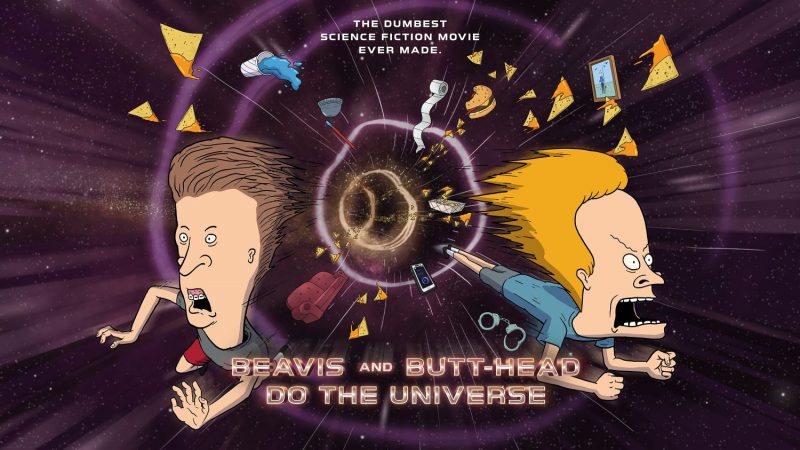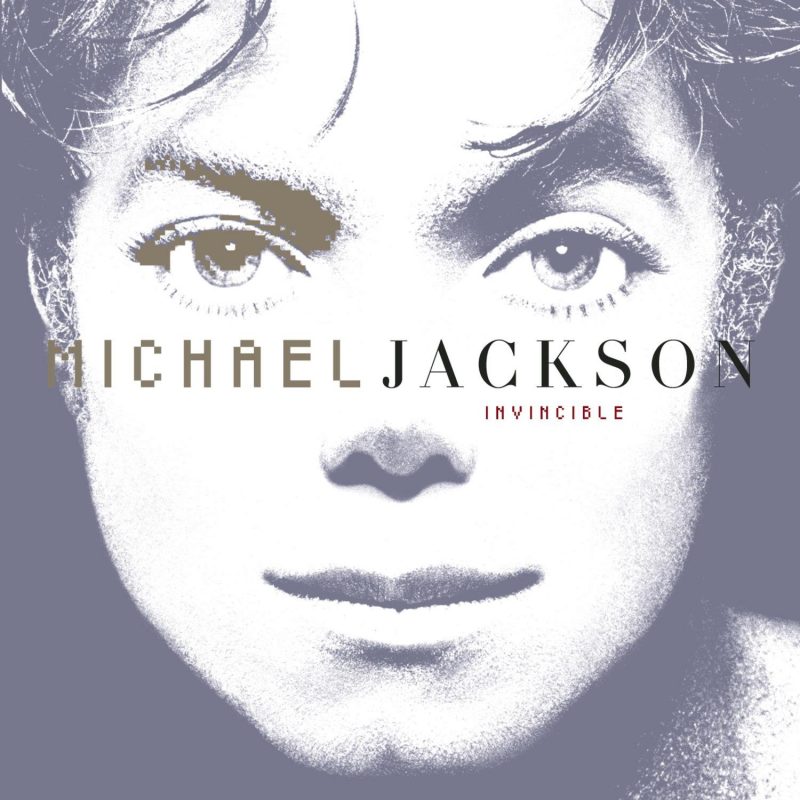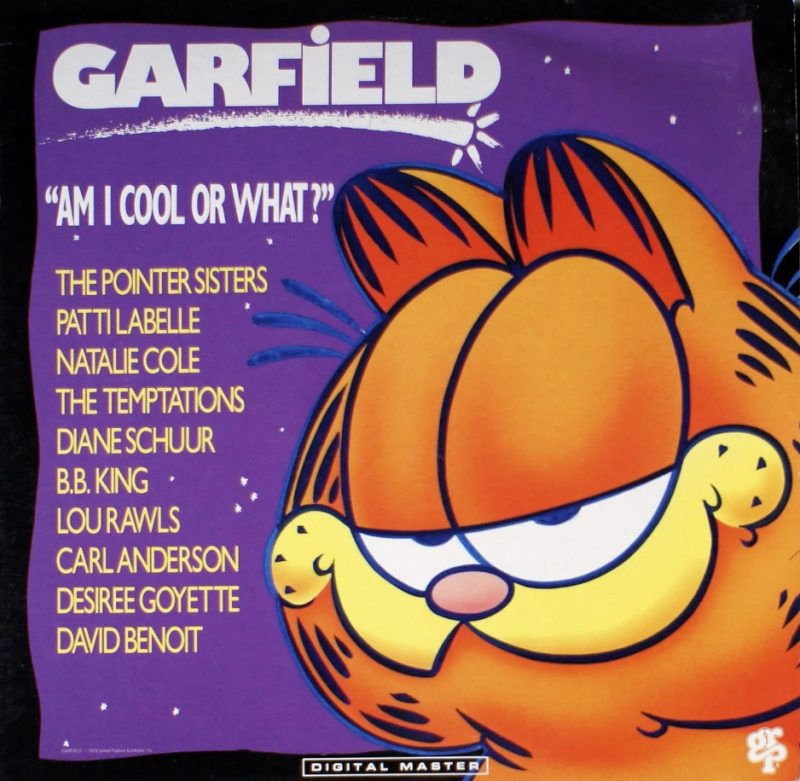
As a kid, I watched Beavis and Butthead with the understanding that they’d prove a fleeting pleasure. “Soon I’ll be too old for this crap and it won’t be funny anymore.”
I am now very, very old, and still waiting for that day to arrive.
Maybe Mike Judge is a genius, or maybe B&B is so simple that it’s impossible to screw up, but the formula continues to work after thirty years. Beavis and Butthead are still two idiots who stumble through life mouth-breathing and misunderstanding everything that happens to them, and that’s all they will need to be. If only life was so simple for the rest of us.
The plot involves Beavis andButthead literally failing upward. After trashing a science fair (“Did we win the science fair?” “Even better, Beavis. We kicked its ass.”), a judge orders them to attend space camp for at-risk youth. An astronaut sees them, believes they are naturally gifted astronauts (a recurring plotline of B&B is the adult who mistakes them for secret geniuses), and takes them into orbit to study a black hole approaching Earth. In space, they create havoc, fall into the black hole, and emerge in the year 2022.
There’s the obligatory larger plot about government coverups and an incipient apocalypse, but the bulk of the comedy comes from them interacting with this new, strange world. Beavis thinks Siri is an actual woman and sexually harasses her. Later, the duo wander into a college class, are told that they have “white male privilege”, and start using that as carte blanch to do whatever they want. “Step aside please. We have white privilege.”
A 4channer once proposed a movie idea: a generic 90s bully time-travels to a modern high school full of furries and tenderqueers. B&BDTU is almost that movie. Aside from being funny this solves the main problem with the characters: they’re so indelibly a product of the 90s. What’s B&B’s main form of entertainment? To sit on a couch watching TV. Few kids do that anymore. They were further characterized by their love of heavy metal, which hasn’t been a mainstream force in a long time.
The Simpsons never knew how to upgrade its stock 90s setting into the modern age, but Mike Judge draws attention to the cultural gap. His duo is now more oblivious than ever.
There’s lots of bite in Judge’s comedy but no real cruelty. He isn’t mocking anyone except Beavis & Butthead, and even that’s not true mockery. The show was always a parody of boomer paranoia about Generation X (that they’re morally vacuous retards who just want to stare at bouncing boobs on MTV all day). To think Beavis & Butthead exists to ridicule Generation X is as misguided as thinking blaxsploitation exists to ridicule African Americans. And even if they’re figures of fun, so what? Beavis and Butthead are immune to mockery. That’s their power. Deplore their lack of morality, and they’d simply wheeze-laugh. “Heh heh…you said ‘oral’.”
And that brings me to an insight I had about Beavis and Butthead.
In the 17th century, a philosophical debate raged about the nature of mankind. Are humans endowed with an innate moral sense (Shaftesbury), or are we natural savages who must be disciplined by an external force such as civilization (Hobbes)?
In the 20th century, evolutionary theory offered a new answer: we’re both.
Imagine that humans come in two varieties: nice guy and bully. When a nice guy meets an bully, the bully wins. But if bullies become too common, nice guys gain an advantage (because bullies waste time picking pointless fights with each other while nice guys don’t). Over time, an equilibrium of nice guys to bullies is found (attach numbers to this simplistic model and you even calculate the exact ratio). The point is, you wouldn’t say that humans are naturally nice or naturally bully, you’d say that our species is split between two competing strategies. This is the insight of John Maynard Smith’s hawk/dove theory.
It occurs to me that Beavis and Butthead occupy one half of a hawk/dove strategy. The fact that they’re stupid and selfish isn’t a failing, it helps them. David Van Driessen is moral and empathetic, but this gets him exploited by Beavis & Butthead at every turn. Tom Anderson is conservative and proud to be an American, even after his country literally rapes him in the ass. Likewise, the social justice warriors have an elaborate set of shame-based social theories that Beavis & Butthead promptly weaponize against them without even knowing they’re doing so. It’s like intelligence and all its fruits (morality, empathy, time preference) is actually a harmful virus, and only Beavis & Butthead are immune.
I’m probably overthinking things myself. B&B is a fictional show. Whenever the idiots win, it’s because a writer made it so. But I still think B&B is pointing toward a real thing: intelligence is a virtue, but not a universal virtue. In a universe of rippling chaos, sometimes it’s the stupid who win.
Invest wisely and your portfolio will grow 9.89% YOY. Meanwhile, an 80 IQ truck driver just bought a lottery ticket and made a 133,333x return in five minutes. In the long term, intelligence wins out, but in the short term, the winners are usually stupid. And sometimes, the short term is all that matters.
Christopher Columbus’s voyage to the Indies was only somewhat less moronic than Beavis and Butthead going to space to get laid. But it led to the Columbian Exchange, the historical event of the millennium. Who knows, maybe the world really will be saved by a man with a T-shirt pulled up over his head, screeching about TP for his bunghole.

Michael Jackson’s recording career came to a sad conclusion on October 30, 2001. He should have released Invincible in September, when it would have only been the second greatest tragedy of the month.
It’s not an album, it’s a PR statement: “don’t listen to what everyone’s saying about me. I’m a normal guy!” By 2000 Jacko’s public image was absolutely out of control and he’d had two options: either rebrand himself as a Howard Hughes-type freakshow, or tamp down the weirdness somehow.
He made the boring choice, or perhaps Sony made it for him. The label had a lot invested both in Invincible’s success (its thirty million dollar production cost remains an industry record, though Michael demanded still more money and accused CEO Tommy Mottola of racism when he wouldn’t pay), and in its main star not appearing like a total lunatic. Before anything else, this album tries to not rock the boat, and unfortunately it succeeds.
Invincible wants to be vapid millennial R&B and follows a formula. Ballads, soft strings, “edgy” songs containing glitched-up funk beats and rapping, guest spots by normal wholesome dudes (ie, R Kelly), lyrics spat out by a Platitude Bot 2000, and when ideas run out (almost immediately) still more ballads. Most albums are accidentally forgettable. Not so here. Invincible was conceived and executed with that goal in mind.
The biggest problem with Invincible – aside from the fact that there’s nothing creepier than a man loudly insisting that he’s normal – is that it’s extremely dull. Who wants to hear a former titan ripping off people who were ripping him off to begin with? The lyrics (aside from “Privacy” and the nauseating “The Lost Children”) are just all about love and romance, and the music just blurs into Boyz II Men (emphasis on the boys, I guess).
Sony was heavily invested, but the same can’t be said for Michael. He barely seems to be in the studio, and he projects not an iota of coolness or attitude into these songs (which aren’t worthy of them in any event). He moon-shuffles. He’s a Smooth Criminal whose offense is an unpaid parking ticket, a Speed Demon doing 62 in a 60 zone. I aspire to someday be this indifferent to thirty million dollars landing in my checking account.
Needless to say, he didn’t tour off Invincible, sparing us the comedy of seeing “You Rock My World” on a setlist with “Don’t Stop ‘Till You Get Enough”. He made a few media appearances. For example, in 2003 the deputies of Santa Barbara County Sheriff’s Dept got a unique meet-and-greet photo session when Mr Normal was charged with seven counts of child sexual abuse.
His songwriting talent had already started to crumble on HIStory and here it’s completely gone. Sixteen bad songs. No good ones. If you want to hear music like “Billie Jean”, you’re in luck. In 1982 Michael Jackson released an album called Thriller, and by sheer coincidence it has a song that sounds exactly like “Billie Jean”! It even has the same title! Don’t listen to this album, though. It’s shit.
I am sorry if I seem to dislike Michael personally. I actually don’t understand him at all. The more I learn and read and expose myself to his personality, the more my noncomprehension deepens. There’s something alien and unreachable about him. But I am repulsed by the parts I see: the glimpses of squirming tentacles behind an impenetrable shell.
I am strongly persuaded that he molested children. This casts much of his character (his philanthropy, his generosity) in a different light: the deeds of a manipulator trying to escape consequences. It makes his war against the paparazzi far less sympathetic. I hear “You keep on stalking me, invading my privacy. Won’t you just let me be.“, remember Robson’s story about finding bloodstains in his underwear, and accept that maybe Michael’s privacy should, in fact, have been invaded. The paranoid tenor of his later work seems less fanciful: it was no delusion, because Michael actually had everything to hide.
His fans are awful. He was incredibly talented as a musician, but in the 90s this talent was eclipsed by a different skill: building and leading a kind of cult. He is a fascinating example of a secular religious icon, and to this day, living Thriller zombies haunt Twitter and Tiktok, circulating his apologetics. The basic thrust is that everything that went wrong for Michael – his finances, his appearance, his death – was someone else’s fault.
There’s a grain of truth to this. Michael Jackson never had a chance at living a normal life. But his fans ignore Michael’s agency (and four hundred million records sold buys a lot of agency), objectifying him to the level of a puppet.
Did Conrad Murray cause his death? Yes, the Jackobots say. He gave him surgical anesthetic as a sleeping aid! Bad doctor! They don’t ask the next question: who hired Conrad Murray to do this? Answer: Michael. They also don’t ask what would have happened if Murray had refused this stupid and insane order. Answer: Michael would have fired him, and found a different doctor.
The same can be said for the ruin of Michael’s face, his oversized chin implant, the nose whittled away like a blade, etc. Unneeded operations. But what would be the point of a plastic surgeon refusing to perform them? Michael had endless money to indulge his body dysmorphia. He would just go to someone else. The problem was always Michael. His story is one of tragedy, victimization, and self-destruction.
But self-destructive people can make fascinating art, and this was Michael’s saving grace. I’d like to pretend his recording career ended with HIStory. That album, like the one before, was a paranoid, sweaty jumble of blame-laying and resentment. Disturbing though it was, it made for compelling listening. You felt you were getting ringside seats for a man’s breakdown, and you got some strong songs, too: “Scream” and “Stranger in Moscow” kick the shit out of everything on this album. There’s a class of words in English better known by their opposites (gruntled, hinged, domitable, and so on). Michael Jackson’s last album is very vincible indeed.

Garfield only has value as a deconstruction of itself. Jazz/R&B label GRP Records accidentally discovered this fundamental fact about the universe in 1991, when they released Am I Cool Or What?, the first ever Garfield concept album.
“Garfield concept album” sounds like a 4chan musical shitpost like MoonMan. Incredibly it’s a real product that was released on both cassette and CD, for a double dose of Garfield madness.
A cynical mind might suspect that the Garfield mythos cannot support a full-blown concept album. The character isn’t exactly Ziggy Stardust: Garfield is to comics what “Jim Davis” is to names, a desolate TS Eliot wasteland of unfettered blandness. I was a Garfield fan for ten seconds in 1997 because it replaced a comic I hated (Cathy) in the Sunday funnies. Then I actually read it and realized I’d cured a toenail disease with an amputation. It was the least funny thing I had ever seen. You can’t even use it as lavatory paper, because any paper containing Garfield has shit on it by definition.
Want to know why Garfield is bad? It’s often asserted that this is the all-time funniest Garfield strip…

Yes, I agree it’s funny. But it has nothing to do with Garfield. He is pointless. Not only could you cut him out with scissors without affecting the gag, he actually makes it worse by being there. (Why is he reacting in disappointment? Was he hoping to hear a long sponsored message?) It’s peabrained nonsense, even within its own universe.
The true load-bearing wall of Garfield is Jon Arbuckle, whose character trait (neurotic insecurity) at least enables things to happen. Garfield, by contrast, is a blob. Take Jon out of Garfield and the comic collapses into a black hole: take Garfield out of Garfield and it stays the same or becomes funnier.
What can you do with a character so bland? What can’t you do? GRP’s pitch meeting must have gone like this:
“Our market research team has identified four traits with the core Garfield brand: he’s lazy, he’s fat, he eats lasagne, and he hates Mondays. If we took each of those traits and wrote a song about it we’d have almost 50% of 1/2 of a real, honest to God album! Ka-ching! This is an even better idea than our Samuel ‘Screech’ Powers prog-rock suite!”
Obviously they had to pad it out some. Neither “I Love It When I’m Naughty” and “Next to You I’m Even Better” have anything to do with Garfield. I think they were included because they were written by a person called Catte Adams, by which standard Cat Stevens, Jon Bon Jovi, and One Direction should be on here. (Get it? OD? Odie? If Jim Davis could write KWALITY JOKES like that, the comic would be cooking with gas.)
I would call the music an afterthought but that would incorrectly imply that any sort of thinking was involved. It’s very cheesy and cheap, with sampled lifeless drums that sound like they’re coming off a midi keyboard. It doesn’t sound close to jazz, it’s more like New Kids On The Block or Billie Ocean or something. “Shake Your Paw” has a stuttered horn sample (think “Owner of a Lonely Heart” by Yes) but that’s the only musical point of interest I can recall.
What’s amazing is that they recruited a stable of R&B/soul greats to make this turd. BB King. The Temptations. Natalie Cole. Just how broke were those guys by 1991? That leads to a fascinating possibility: with the demise of the music industry, there has never been a better time to recruit legendary musicians for cheap. Who’s with me? The world must hear Am I Cool Or What? II.




